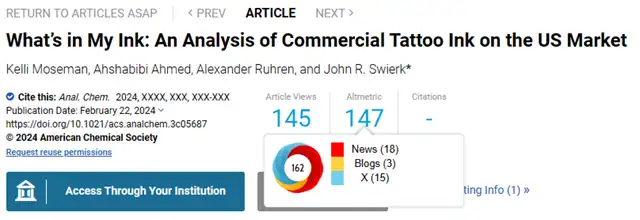90% of U.S. Tattoo Inks Contain Unlisted Ingredients
- Normal Liver Cells Found to Promote Cancer Metastasis to the Liver
- Nearly 80% Complete Remission: Breakthrough in ADC Anti-Tumor Treatment
- Vaccination Against Common Diseases May Prevent Dementia!
- New Alzheimer’s Disease (AD) Diagnosis and Staging Criteria
- Breakthrough in Alzheimer’s Disease: New Nasal Spray Halts Cognitive Decline by Targeting Toxic Protein
- Can the Tap Water at the Paris Olympics be Drunk Directly?
90% of U.S. Tattoo Inks Contain Unlisted Ingredients
- Should China be held legally responsible for the US’s $18 trillion COVID losses?
- CT Radiation Exposure Linked to Blood Cancer in Children and Adolescents
- FDA has mandated a top-level black box warning for all marketed CAR-T therapies
- Can people with high blood pressure eat peanuts?
- What is the difference between dopamine and dobutamine?
- How long can the patient live after heart stent surgery?
90% of U.S. Tattoo Inks Contain Unlisted Ingredients
Tattoos are a form of self-expression, rebellion, memorials to family and tradition, and sometimes even a spontaneous decision made under the influence of alcohol.
Whatever the reason, everyone getting a tattoo hopes that the ink being used is safe. Researchers analyzed tattoo inks produced by well-known manufacturers in the United States and found that 90% of them contained ingredients not listed on the labels, including some known to affect health.
The study highlights the need for stricter regulation of tattoo ink production.
Researchers at Binghamton University in New York found that the situation may be more concerning than previously thought. Among the 54 tattoo inks they analyzed, ranging from major U.S. brands to small manufacturers, 90% had significant label discrepancies, particularly in additives and pigments.
Here are some of the findings:
– Polyethylene glycol (PEG) was the most common unlisted additive. While it is often used to treat constipation, prolonged exposure to PEG can have harmful effects, including kidney failure or heart failure.
– Propylene glycol, which is associated with skin irritation and allergic reactions.
– Butylated hydroxytoluene (BHT), a food preservative that can disrupt the endocrine system, affecting testosterone levels and sperm quality. Additionally, it may lead to liver enlargement, kidney dysfunction, and lung inflammation.
– Methenamine, an antibiotic commonly used to treat urinary tract infections.
– 2-phenoxyethanol, a bactericide. While cases of contact dermatitis and urticaria after exposure to this substance are rare, the FDA has warned that breastfeeding infants whose mothers are exposed to 2-phenoxyethanol may experience neurological problems and diarrhea.
– 1-butanol, an alcohol commonly used as a solvent and fuel, reportedly causes irritation to the eyes, lungs, and skin upon repeated or prolonged exposure.
The researchers analyzed inks from brands such as Intenze, Dynamic, Solid Ink, Starbrite, World Famous, Mom’s Ink, Solong, One Tattoo World, and Raw Ink. Dynamic was the only manufacturer that properly labeled all pigments.
The concentrations of unidentified substances found in tattoo inks were at levels of 2,000 parts per million or higher, which is considered high concentration. The concentrations of other components may be too low to observe but could be significant in other aspects, further emphasizing the need for strict control over production. Compared to the United States, the European Chemicals Agency (ECHA) has stricter regulations on tattoo inks in the European market.
Lead author of the study, John Swierk, stated, “We hope that manufacturers take this as an opportunity to reevaluate their production processes, and we also hope that artists and customers use this as an opportunity to push for improved labeling and production practices.”
The researchers could not determine whether substances were deliberately added to the inks without being listed or whether manufacturers were provided with incorrectly labeled or contaminated materials. Additionally, it is not uncommon for multiple ink manufacturers to have the same owner, raising concerns that labeling issues may extend to inks not analyzed in the study.
Before 2022, the FDA classified tattoo inks as “cosmetics” and therefore did not regulate them. The U.S. Congress passed the Modernization of Cosmetics Regulation Act (MoCRA) that year, marking the first regulation of tattoo inks.
Swierk stated, “The FDA is still figuring out what this will look like, and we think this study will impact the discussions around MoCRA. This is also the first study specifically targeting inks sold in the U.S. and possibly the most comprehensive study because it examines both the pigments nominally left in the skin and the carrier packages suspending the pigments.”
The researchers said their study aims to empower tattoo artists and their clients.
Swierk said, “The goal of our extensive research is to empower artists and their clients. Tattoo artists are serious professionals who dedicate their lives to this craft, and they want to deliver the best results for their clients. We’re trying to highlight some of the flaws in production and labeling.”
The study was published in the journal Analytical Chemistry.

90% of U.S. Tattoo Inks Contain Unlisted Ingredients
(source:internet, reference only)
Disclaimer of medicaltrend.org
Important Note: The information provided is for informational purposes only and should not be considered as medical advice.



